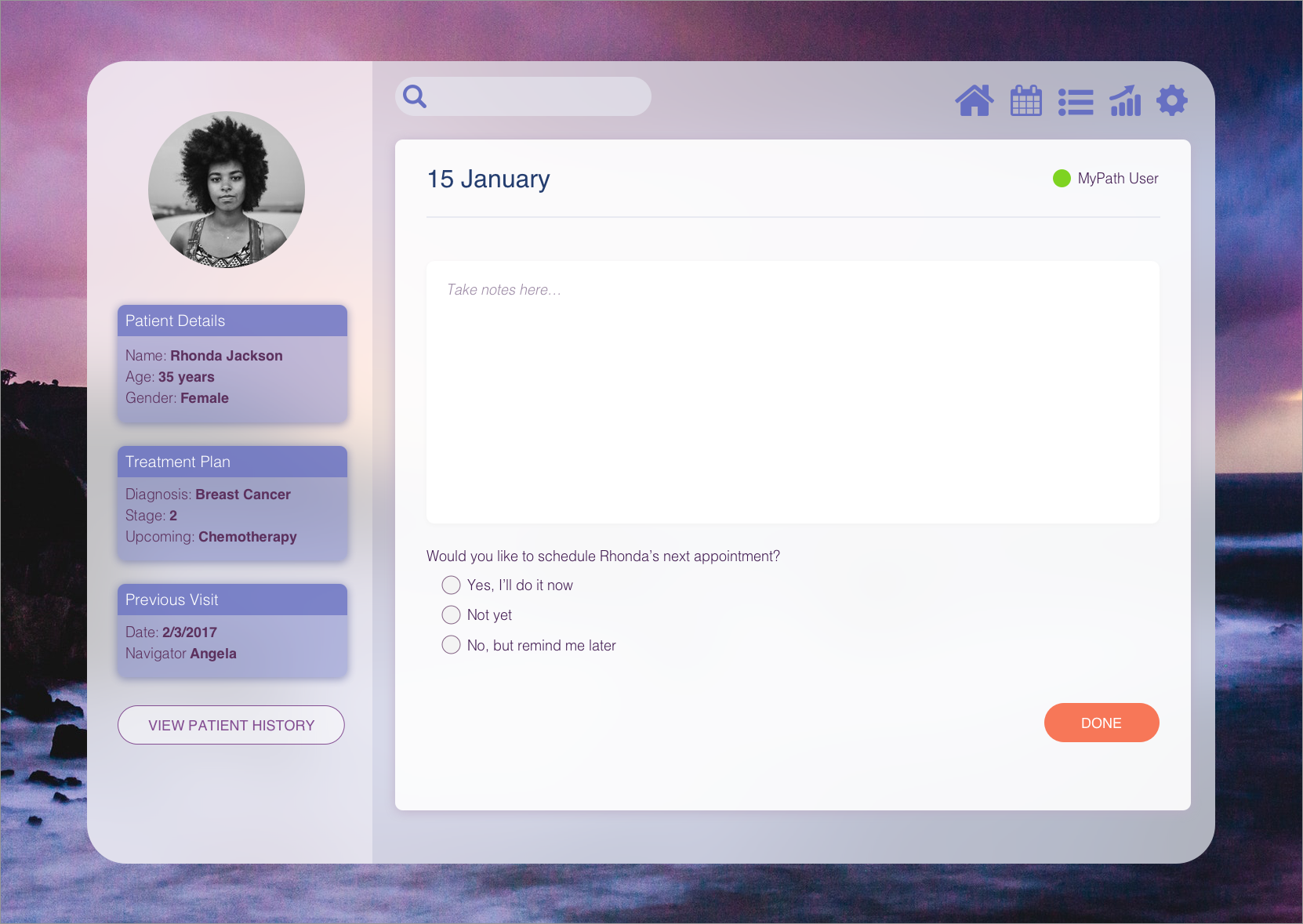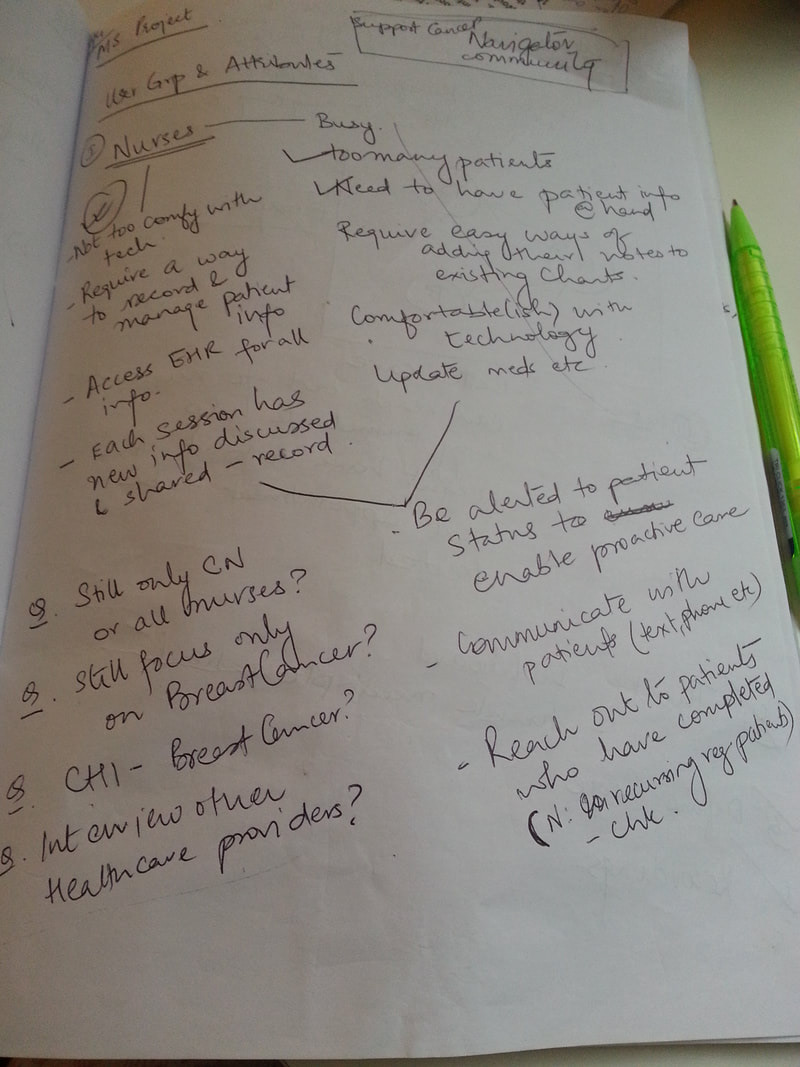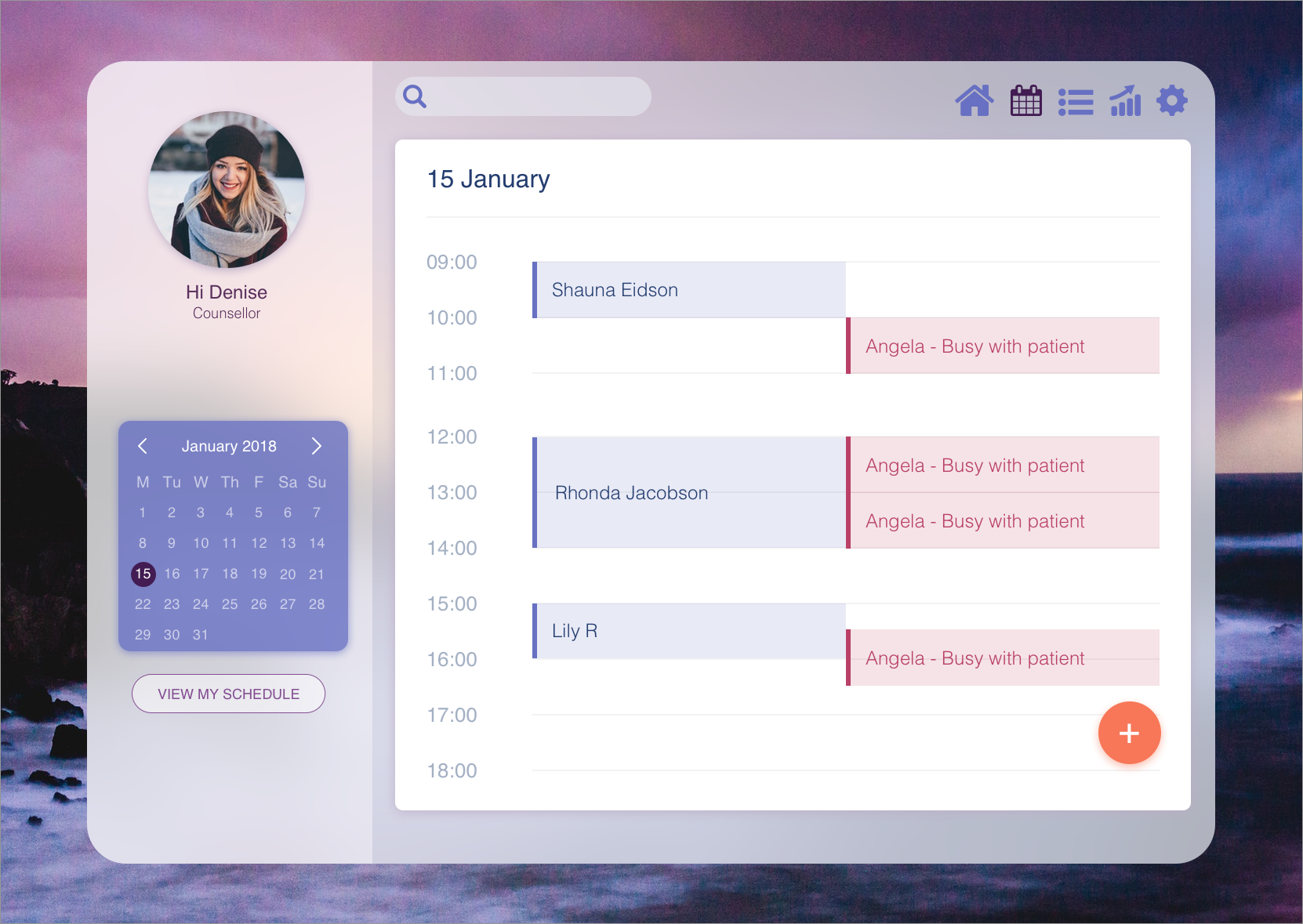The Goal: The goal of this project is to understand how technology can help support breast cancer patients' dynamic needs over a period of time and how this data can be integrated into the existing health system.





Duration : 8 months | Team : 2
My Role : UX Researcher, UX Designer, Chief Architect
My Responsibility : Interviewing users, Journey Mapping, Design Ideation and Brainstorming, Creating Initial Mockups, Interactive Prototyping
My Role : UX Researcher, UX Designer, Chief Architect
My Responsibility : Interviewing users, Journey Mapping, Design Ideation and Brainstorming, Creating Initial Mockups, Interactive Prototyping
Problem Statement
Cancer Navigators provide personalized in-person support to Cancer patients with the sole aim of reducing barriers to care. They help with many patient needs that are not addressed by the traditional healthcare system today like providing emotional support, helping with health insurance and counseling etc. This project focuses on reducing barriers for Cancer Navigators that ultimately would enable them to spend more time caring for their patients.
This project was born whilst working on the MyPath project (Personalized Mobile Tool to Support Chronic Healthcare Journeys). While MyPath focuses on the patients and is a big strength to this, this project directly impacts the Cancer Navigators.
This project was born whilst working on the MyPath project (Personalized Mobile Tool to Support Chronic Healthcare Journeys). While MyPath focuses on the patients and is a big strength to this, this project directly impacts the Cancer Navigators.
Who are Cancer Navigators?
Cancer is not only an unrelenting battle in itself, but in addition, they are other factors that continue to overwhelm the patients even more. Whether it is a need for financial assistance or stress management, these certainly add to the misery of the patients. Fortunately, organized support has emerged to help patients through these challenges a.k.a Cancer Navigators.
Not only do Cancer Navigators have complete knowledge about your condition, they provide a full range of treatments that may include complementary therapies such as meditation, acupuncture, massage, nutrition, yoga or others that can often increase the endurance and confidence of a patient to respond to medical therapies. Moreover, they offer support and reassurance.
Not only do Cancer Navigators have complete knowledge about your condition, they provide a full range of treatments that may include complementary therapies such as meditation, acupuncture, massage, nutrition, yoga or others that can often increase the endurance and confidence of a patient to respond to medical therapies. Moreover, they offer support and reassurance.
A Cancer Navigator helps the patient adjust to her 'new normal'
The Problem Space
Each cancer navigator is responsible for upwards of 200 patients. They need to have each patient's’ health information, their health records, any changes from the last time they came in etc. so that they may be able to guide the patients and help them in the right manner. It is hard enough to keep track of this information for a handful of patients let alone hundreds of them. Usually, a navigator has to spend a few minutes to get up to speed with the patient’s medical history, their treatment plan and any changes, before they can actually help a patient. Although a number of applications have been developed to support cancer patients, not much work has been done to help facilitate the interaction between the cancer navigators and the patients.
Connected ecosystem
Also, it is intriguing to note that most of their work is still paper-based. This is a complex system owing to the sheer volume of the people each navigator handles! For instance, each cancer patient needs to come into the clinic once a week to fill a paper-based NCCN distress tool. This records the patients’ side-effects and other systems including the severity experienced. It is the task of the navigator to then collate all this information and guide the patient accordingly. This is one of the many such examples. While the cancer navigators are motivated to do their job, this adds an unnecessary burden onto them. There is therefore, scope to ease this process for them and what better way than technology to help solve this.
Another thing as learnt from past interviews is that the cancer navigators often find it very difficult to keep connected with survivors once treatment is overmainly due to sheer volume of patients. It is a very tough transition for patients as they go from an existing support system to finding the new ‘normal’. This tool will help address this concern by enabling the navigators to connect with survivors via text messages, emails etc. and continue that interaction as well as support to the patient until the patient has adjusted to this new ‘normal’.
Problem space
Design Ideation and Brainstorming
It is my vision to help these navigators manage all of this information in a format which requires them to only spend a minimum amount of time to get upto speed with all the patient information they need. I believe that, eventually, there is a possibility of creating a coherent ecosystem with the cancer navigators and cancer survivors (maybe even doctors) within which the navigators are immediately notified of any changes in patient's’ health (like symptoms / side effects etc) without the need for the patient to actually come into the clinic outside of scheduled weekly visits. This would result in easing the process for both the navigator and more importantly, the patient.




As observed in the interview session, the clinic has available infrastructure (desktops) that the team uses but only to access Medical Health Records of their patients. This brings to notice two things. One, the team is comfortable using desktops. Two, although technology is available, it is currently underused - no one ever thought to help digitize the whole operation!
With the successful roll-out of the MyPath application to patients for a year long study, we already began to see patterns in the data collected from MyPath. It gave us a direct insight into what the patients are currently experiencing making it a valuable as well as actionable insight for the Navigators - assuming it is packaged in a way they can consume this information. Not only will it help them triage better, it also provides them with a way to develop targeted resources to further their vision of personalized patient support.
My idea proposes to utilize what they already have to connect with what we already have to help them triage better. A tool that will help navigators monitor the patients over time without adding a large time burden or any additional cognitive load on their already constrained schedules.
With the successful roll-out of the MyPath application to patients for a year long study, we already began to see patterns in the data collected from MyPath. It gave us a direct insight into what the patients are currently experiencing making it a valuable as well as actionable insight for the Navigators - assuming it is packaged in a way they can consume this information. Not only will it help them triage better, it also provides them with a way to develop targeted resources to further their vision of personalized patient support.
My idea proposes to utilize what they already have to connect with what we already have to help them triage better. A tool that will help navigators monitor the patients over time without adding a large time burden or any additional cognitive load on their already constrained schedules.
Proposed Design Idea
Low Fidelity Prototypes
Please find below some screens from my first couple iterations.




Medium Fidelity Prototypes
Please find below some screens of my medium fidelity prototype that incorporated feedback from two rounds of testing.

Data Visualization

Data Visualization

Data Visualization

Data Visualization

Data Visualization

Data Visualization

My Schedule today

Patient appointment record

Patient Roster
Here's a video if you wanted to see more.
High fidelity prototype
Please find below a few of the screens from my high fidelity deliverable.

My Schedule

Shared calendar

Session notes

Patient Roster

Patient Roster - On hover (Actions)

Interactive Dashboard with data visualization
Impact
Up to this point, the Cancer Navigators at the Cancer clinic in Rome, Georgia banked on recall, manual process and leaned heavily on the relationships they had built with patients over time. The manual process took time away from patient care which was the biggest pain point for Cancer Navigators. With this Dashboard -
Data Visualization: The Cancer Navigators will now have access to rich actionable data that they can use to inform the services they offer, the items they need to stock up for as well as events they organize for the Survivors.
Insights from Dashboard: They will be able to identify and analyze patterns over time which will enhance patient care and ultimately, benefit the Survivors.
Connected Ecosystem: This dashboard presents the information collected from MyPath (Tablet app for Survivors) and gives the Navigator the complete information of the patient, even if they meet after a long period of time.
Continuity of care: Navigators will now be able to easily search through Survivors on the 'Patient Roster' and keep in touch with them including, reminding them of upcoming appointments, notifying them to schedule one if they haven't had one in a while and simply, keep in touch with Survivors once treatment is over.